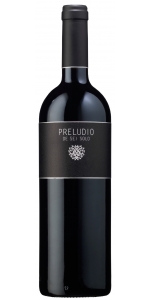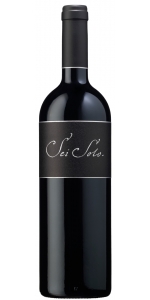Wine from Sei Solo Bodegas y Vinedos

Sei Solo and Preludio represent the artistic vision of Javier Zaccagnini. After 20 years of experience in Ribera del Duero, he spent six years with the Quality Control Regulatory Board (Consejo Regulador) of the Appellation Contrôlée, and then the subsequent 14 years as director of Aalto, a flagship of Ribera del Duero that Javier co-founded with the great Mariano Garcia, the man who famously made Vega Sicilia for over 30 years.
Sei Solo is named after Johann Sebastian Bach's - Javier's favorite composer - six solos for violin, honoring his BMW 1001-1006 violin sonatas. In fact, their wine labels are manuscript letters from J.S. Bach
The grapes for this wine come vineyards in the villages of La Horra, Gumiel de Izan and Moradillo from 12 to 80 year-old vines.
Displaying a good vibrant deep cherry red color with fragrant, clear notes of cherry drop and violet there is a beautifully unadorned yet brooding quality to this; it feels deep, vinous and vibrant, flecked with bright red fruit notes, sweet earth and a darker, more spiced character on the finish.
The grapes for this wine come vineyards in the villages of La Horra, Gumiel de Izan and Moradillo from 12 to 80 year-old vines.
Displaying a good vibrant deep cherry red color with fragrant, clear notes of cherry drop and violet there is a beautifully unadorned yet brooding quality to this; it feels deep, vinous and vibrant, flecked with bright red fruit notes, sweet earth and a darker, more spiced character on the finish.
Sei Solo Ribera del Duero Tempranillo is made from 100 percent Tempranillo.
Named after Bach's six solos for violin, Sei Solo represents Javier Zaccagnini's vision of elegant, high-toned Ribera del Duero from the powerful, mineral soils of La Horra and the top vineyards of Barroso and Acos that are planted with old vines of 60 to 90 years old.
Displaying wonderful clarity of fruit and excellent transparency to the multi-layered flavors, there is no new oak influence on this at all, resulting in a wine that has nothing to hide behind. Deft tannins support a taut, mineral, dark fruited wine that, while tight knit and brooding is tremendously refined and vital and not at all tiring to drink. A Ribera built on elegance, refinement and nuance that promises great things for the future. A star is born.
Fermented in stainless steel tanks of small capacity, adapted to the size of every vineyard, allowing to do individual fermentation for every different plot.
Short and careful pumping over, never reaching high temperatures to respect the fruit and avoid over extraction of the tannins, gaining the full potential of elegance and finesse of the old vines. After alcoholic fermentation the wines are racked to two-year-old French barrels to undergo malolactic at low temperature ( less than 14 degrees C) . This process takes several months. When malolactic is finished, the wines are racked to 600 liter big barrels of French oak, which are not new to avoid a loss of balance and style of the wines. Aging in barrels for 20 months.
Review:
Made with Tempranillo from 60- to 100-year-old vines, this wine has a bouquet of purple plum, black currant and a hint of cedar. Plush tannins and striking acidity provide a backdrop to black cherry, Mission fig, caramel, milk chocolate and juniper-berry flavors. I did not want this wine to end; it is a gorgeous pour on its own, but to get the most out of it enjoy it alongside a Porterhouse or Tomahawk steak. Drink through 2034. — Mike DeSimone
- Wine Enthusiast (May 2024), 97 pts & Cellar Selection
Sei Solo Ribera del Duero Tempranillo is made from 100 percent Tempranillo.
Named after Bach's six solos for violin, Sei Solo represents Javier Zaccagnini's vision of elegant, high-toned Ribera del Duero from the powerful, mineral soils of La Horra and the top vineyards of Barroso and Acos that are planted with old vines of 60 to 90 years old.
Displaying wonderful clarity of fruit and excellent transparency to the multi-layered flavors, there is no new oak influence on this at all, resulting in a wine that has nothing to hide behind. Deft tannins support a taut, mineral, dark fruited wine that, while tight knit and brooding is tremendously refined and vital and not at all tiring to drink. A Ribera built on elegance, refinement and nuance that promises great things for the future. A star is born.
Fermented in stainless steel tanks of small capacity, adapted to the size of every vineyard, allowing to do individual fermentation for every different plot.
Short and careful pumping over, never reaching high temperatures to respect the fruit and avoid over extraction of the tannins, gaining the full potential of elegance and finesse of the old vines. After alcoholic fermentation the wines are racked to two-year-old French barrels to undergo malolactic at low temperature ( less than 14 degrees C) . This process takes several months. When malolactic is finished, the wines are racked to 600 liter big barrels of French oak, which are not new to avoid a loss of balance and style of the wines. Aging in barrels for 20 months.
Review:
"A very fine and serious Ribera del Duero that exhibits huge depth and uncoiled complexity. The aromas of spicy toast, chalky minerals, ripe but fresh blackberries, grilled herbs and cocoa powder fade and become more transparent. Well-judged wood influence. Really concentrated, mildly plush and hedonistic. Masses of fine, powdery tannins are fully integrated and cohesively knit. This will age beautifully. 100% tempranillo. Gorgeous. High alcohol, yes, but still poised. Drink from 2027, but this will hold well for years."
- James SUCKLING (December 2024), 97 pts
"The top wine from Sei Solo just seems to get better and better, making the most of a very good vintage in 2021. Sourced from seven different parcels in La Horra, this is an elegant, refined, beautifully judged Tinto Fino from a quality-obsessed winemaker. Framed by subtle oak, it's perfumed and acid-driven with sculpted tannins and a partnership of plum, black cherry fruit and toast. 2026-40"
- Tim Atkin MW (Ribera del Duero 2024 Special Report), 97 pts
- back
Selected Options
Wineries
Categories
Pricing
Countries
Regions
Grape Types
Wineries
Organic/Free Shipping
Thibaut-Janisson Blanc de Chardonnay is made from 100% Chardonnay
Appellation 100% Virginia
Winemaking Notes The grapes are handpicked in small baskets late August and are gently pressed as whole clusters. After a settling of 24 hours, the juice is inoculated with selected Champagne yeast and ferments in stainless steel tanks at low temperature. Once the fermentation is over, the wine ages on the fine lees until the spring of the following year. The blend is then put together and cold-stabilized prior to bottling. The bottling occurs in the spring when the cellar temperature is conducive to a second fermentation in the bottle. The now sparkling wine will age on the yeast for over 24 months. At disgorging, a small amount of dosage liquor is added in order to balance the natural acidity.
Clean, crisp and refreshing! With scents of white flowers, apples and pears. This sparkling wine is elegant and complex with vibrant aromas, and fine active streamers. The depth of complexity is elegant and the intricate nuances of the terroir fill the nose and stimulate the palate. It’s full of youthful, bright and alert acidity.
Pago de Carraovejas Cuesta Liebres is made from 100% Tinto Fino. The plot is located on a terraced hillside located at 900 m above sea level with slopes that range between inclines of 30% and 40%. Red cherry color with purple hues. Ripe fruit aromas, vanilla notes. Suave and unctuous in the mouth. A strong and noble character.
The harvest is carried out by hand using small crates and after passing through a refrigerated container it is transferred into tanks via gravity. The alcoholic and malolatic fermentation is carried out in small French “Haute Futaie” Oak casks with unique and original local yeasts and fermenting bacteria from the vineyard itself, to bring out the very best of the terroir, respecting the uniqueness of each and every vintage. Clarified with egg whites and bottled by gravity with natural cork stoppers.






